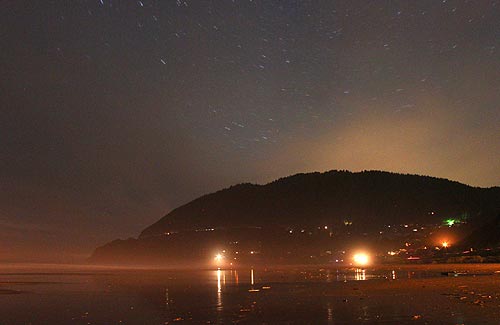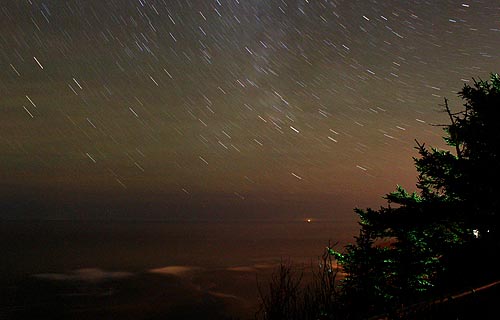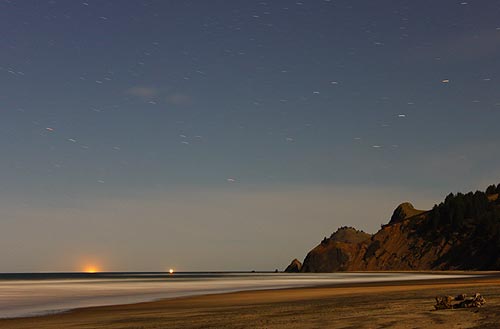Odd Astronomy: Curious Colors of the Galaxy as Seen from Oregon Coast
Published 12/05/2014

(Oregon Coast) – Ever wondered if the Milky Way Galaxy looked different in other places around the Earth?
Indeed it does on the Oregon coast. But you have to use a camera to notice. This is one trip to space you can take with the beach as a launching pad - a journey of colorful discovery full of startling surprises that only show up on your memory drive. (Pictured above: Manzanita).
The science behind these sights is fascinating as well.
Just south of Cannon Beach, on the north Oregon coast, sits Silver Point and its nubby seastacks. Multiple layers of clouds and breaks in them make for distinctive shades, also allowing the stars to be seen racing through the sky. A fishing boat in the distance looks like a star on the horizon, while high up above there are shades of green which could well be the Northern Lights. However, it's more likely those are simply a trick of the atmosphere.
The Aurora Borealis is almost never seen by the naked eye on the Oregon coast – but the camera can see it at times with long exposures.
A bit further south of there is Arch Cape, which has no lights that hit the water or the skies. You'll notice not only a variety of subtle shades of colors in the air, but even the stars have different colors.
Is this that Doppler effect that astronomers use to judge if a star is coming or going?
No.
According to Jim Todd of OMSI in Portland, numerous gasses in the atmosphere cause the stars to become different colors. But these can’t be seen by the human eye – only a photographic mechanical one like a camera.
This phenomenon shows itself even more on this particular summer night at Cape Foulweather, on the central coast, between Newport and Depoe Bay. Again, those cloud and mist layers create different splashes of colors, like a veil put in front of our galaxy. Most of those shades come from light sources from Depoe Bay to the north and Newport to the south.
Again, this can't be seen by the human eye. To you, the world simply appears black and a few different degrees of gray when looking at this scene in person. Make a long exposure like this one yourself and you'll be plenty surprised by what your rig sees that you don't.
Yet another way this galaxy gets colorized like a classic movie from the Turner company is the moon, such as here at Lincoln City. Under bright moonlight, the stars struggle to be seen by you and the camera. But to the eye behind the lens, it looks like an off-kilter sunlight, dominated by blue. There's also an otherworldly look to it, like daylight in another, alternate universe.
In Oceanside, those Three Arch Rocks look especially surreal on this slightly misty night. That fog makes things darker in the sky, but somehow the faint lights of the tiny town manage to bathe the waves in an esoteric glow. It takes the camera a long, long exposure to get such star streaks, which happened rather easily on this eve as to get much of anything substantial took about 15 minutes for just one photograph.
Oregon Coast Hotels for this - Where to eat - Maps - Virtual Tours
More About Oregon Coast hotels, lodging.....
More About Oregon Coast Restaurants, Dining.....
LATEST Related Oregon Coast Articles
Likely just before dawn best hour but peak happens during daylight. Weather
Dark Sky Week is Prime Along Oregon Coast: Where and Where Not to Go
General guide to dark sky viewing from south to north coast. Astronomy
Sizable Price Drop, Deals in Lincoln City During Quiet of April on Central Or...
20 perc off at A1 Vacation Rentals across its roster, including Gleneden Beach. Lincoln City specials
Upcoming S. Oregon Coast Events Include Gem Show, History: Coos Bay, Bandon
May 6 talk at Coos History Museum, Mayfly Fest May 17, Bandon Rock / Gem Show June 7,8
Washington Coast Cleanup on April 19 - Coinciding with Oregon Coast's SOLVE E...
From the Puget Sound to Long Beach, alongside Oregon's cleanup. Washington coast events, Seaside events
Astoria's Riverwalk Gets New Lighting, More N. Oregon Coast Roadwork
Delays coming this summer, but the riverwalk has a new look. Seaside, Cannn Beach
April Gets Even Cheaper Midweek at Depoe Bay, Lincoln City: Oregon Coast Deals
Off-season rates plus more at Keystone Vacation Rentals. Depoe Bay lodging specials, Lincoln City hotel reviews, Newport hotel reviews
Washington Coast Begins Week of Clam Digs, April 12 Through 18
Long Beach, Twin Harbors, Mocrocks and Copalis at different times. Washington coast events
Back to Oregon Coast
Contact Advertise on BeachConnection.net
All Content, unless otherwise attributed, copyright BeachConnection.net Unauthorized use or publication is not permitted
















































